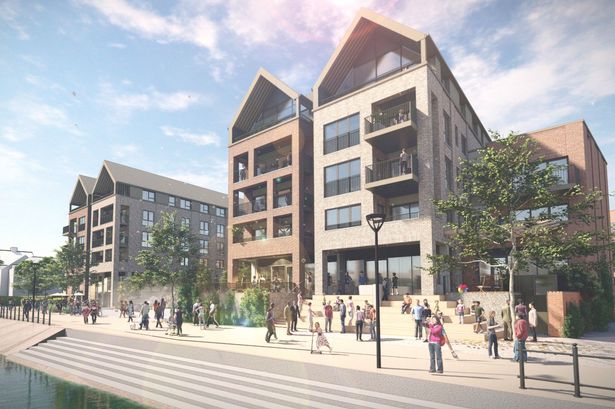
The first look at how the transformation will take place
New images of what a landmark new development on the south side of Bristol’s Floating Harbour will look like once it has been completed have been released, in the week work on the controversial plan finally began.
The transformation of the Baltic Wharf caravan park, which has been a tourist Mecca for more than 40 years, began on Monday when workmen began cutting down scores of trees and clearing the site ready for the construction of 166 new flats.
The site, sandwiched between the famous Cottage pub and Bristol Marina, is one of the few remaining spots along the harbourside that has either been redeveloped into modern housing, been repurposed – like the M-Shed, the Arnolfini or the bars and restaurants of St Augustine’s Reach – or remains a link back to Bristol’s history as a port and dockyard, like the marina, or Underfall Yard.
Baltic Wharf’s caravan site was for centuries a timber yard and, as the docks and harbour industry around it was closed down in the 1970s, it was converted into a caravan park in 1978, at around the same time other empty, derelict or decaying sites were turned into car parks, years before the big transformation of the 1980s and 90s saw flats being built from Mardyke Wharf to Bathurst Basin.
READ MORE: ‘Tree Brides’ anguish as work finally begins on Harbourside flatsREAD MORE: ‘Perfect’ South West caravan park sits eerily empty in the peak of summer
In 2018, the man then in charge of Bristol’s housing said it was ‘a nonsense’ that such a prime harbourside site owned by the city council was a caravan park and hadn’t been redeveloped, and so Cllr Paul Smith added it to the list of sites that would be handed over to Goram Homes, the council-owned housing development company he set up.
Seven years later, and that decision is finally coming to fruition. On Monday, trees were cut down with far less ceremony as the one in 2020 which saw 70 women symbolically ‘marry’ the trees that were a feature of the caravan park.
In 2021 more than 70 women ‘married’ dozens of trees in a ceremony to oppose plans which could see trees being removed from a prospective building site on Baltic Wharf Caravan Club Site, overlooking the Floating Harbour in Bristol(Image: Peter Herridge / SWNS)
And now, Goram Homes has entered into a joint venture with developers The Hill Group, which will see them set up a new company to build and manage the flats. At the same time, Goram has done a deal with Sovereign Network Group (SNG), which will see the housing association buy 66 of the 166 flats to either rent out as social housing, or sell as part of an affordable housing shared ownership deal.
For years, since the Baltic Wharf development was first announced, there has only really been one image of what this key site will look like when it is eventually built. Now, Goram Homes has released more images, which show just how much this site will change the current open and low level feel of the western end of the Floating Harbour.
Images of the development at Baltic Wharf, on Bristol’s Floating Harbour, which will see 166 flats built on land that was until August the Caravan Club site(Image: Goram Homes)
One new image shows how, from the water, the steps down to it and the existing wide harbourside walkway, the site will be dominated by four waterfront-facing blocks of flats, two on either side of an open square area. On the ground floor, there will be commercial spaces, with the most valuable flats above. Residents there will enjoy some of the best views in Bristol, across to the coloured terraces of Cliftonwood and the Clifton Suspension Bridge to the west.
READ MORE: End of an era as Bristol’s harbourside caravan club closesREAD MORE: Tree brides, deadly flooding and caravans – the bizarre saga of Baltic Wharf
Another new image, below, shows the scale of the development from the other side – the north bank of the New Cut River Avon. The caravan park site at Baltic Wharf is located on the narrowest part of Spike Island, the long, thin piece of land created 215 years ago when the New Cut was dug to create the Floating Harbour and divert the tidal River Avon.
The artist’s impression viewpoint is looking down from above the river, with the Cumberland Road frontage of the caravan park site in the foreground. In the distance, the view shows the back of the two-plus-two flats that face out onto the harbourside beyond, and for the first time, there’s an impression of what the ‘back’ of the Baltic Wharf site will look like.
Images of the development at Baltic Wharf, on Bristol’s Floating Harbour, which will see 166 flats built on land that was until August the Caravan Club site(Image: Goram Homes)
There are more low-rise blocks of flats, of four or five storeys, with Goram Homes keen to focus on the green roofs the buildings will have.
Another aspect the green roof image reveals is that there will be an access road through the heart of the site which connects Cumberland Road to the Floating Harbour. At present, the caravan club park was fenced off with no access across Spike Island from one water’s edge to the other.
Other images have been revealed before – including one showing what Baltic Wharf will look like from across the other side of the Floating Harbour at Mardyke, in the evening.
Images of the development at Baltic Wharf, on Bristol’s Floating Harbour, which will see 166 flats built on land that was until August the Caravan Club site(Image: Goram Homes)
This image shows the two gables either side of the development, with two more set back, providing a striking and controversial change to the cityscape at the western end of the Floating Harbour.
Work is expected to begin this year, as The Hill Group begin to prepare the ground for the 166 flats.





